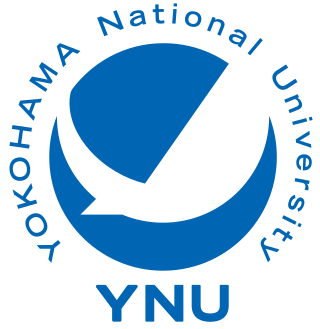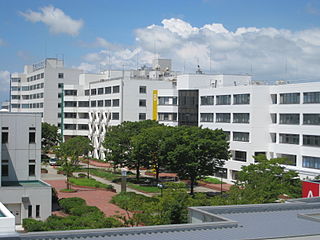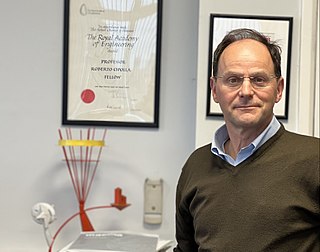
Yokohama National University, abbreviated to Yokohama Kokudai (横浜国大), Yokokoku (横国) or YNU, is a national university located in Yokohama, Kanagawa Prefecture, Japan. Founded in 1876, it became a national university in 1949, and currently comprises five graduate schools and four undergraduate faculties.

Waseda University (早稲田大学), abbreviated as Waseda (早稲田) or Sōdai (早大), is a private research university in Shinjuku, Tokyo. Founded in 1882 as the Tōkyō Professional School by Ōkuma Shigenobu, the fifth Prime Minister of Japan, the school was formally renamed Waseda University in 1902.

Nihon University, abbreviated as Nichidai (日大), is a private research university in Japan. Its predecessor, Nihon Law School, was founded by Yamada Akiyoshi, the Minister of Justice, in 1889. The university's name is derived from the Japanese word "Nihon" meaning Japan. Nihon University now has "16 colleges and 87 departments, 20 postgraduate schools, 1 junior college which is composed of 5 departments, 1 correspondence division, 32 research institutes and 3 hospitals." The number of students exceeds 70,000 and is the largest in Japan.

Hideki Shirakawa is a Japanese chemist, engineer, and Professor Emeritus at the University of Tsukuba and Zhejiang University. He is best known for his discovery of conductive polymers. He was co-recipient of the 2000 Nobel Prize in Chemistry jointly with Alan MacDiarmid and Alan Heeger.

Osaka University, abbreviated as OU or Handai (阪大), is a national research university in Osaka, Japan. The university traces its roots back to Edo-era institutions Tekijuku (1838) and Kaitokudo (1724), and was officially established in 1931 as the sixth of the Imperial Universities in Japan, with two faculties: science and medicine. Following the post-war educational reform, it merged with three pre-war higher schools, reorganizing as a comprehensive university with five faculties: science, medicine, letters, law and economics, and engineering. After the merger with Osaka University of Foreign Studies in 2007, Osaka University became the largest national university in Japan by undergraduate enrollment.

The University of Tsukuba is a national research university located in Tsukuba, Ibaraki, Japan.

The Hybrid Assistive Limb is a powered, soft-bodied exoskeleton suit developed by Japan's Tsukuba University and the robotics company Cyberdyne. It is designed to support and expand the physical capabilities of its users, particularly people with physical disabilities. There are two primary versions of the system: HAL 3, which only provides leg function, and HAL 5, which is a full-body exoskeleton for the arms, legs, and torso.

Osaka Institute of Technology, abbreviated as Dai kōdai (大工大), Han kōdai (阪工大), or Osaka kōdai (大阪工大) is a private university in Osaka Prefecture, Japan. OIT has 3 campuses, Omiya campus located in Asahi-ku, Osaka City, Umeda campus located in Kita-ku, Osaka City and Hirakata campus located in Hirakata City.
Susumu Tachi is a professor of Graduate School of Media Design at Keio University and Professor Emeritus of the University of Tokyo.

Tsukuba is a city located in Ibaraki Prefecture, Japan. As of January 1, 2024, the city had an estimated population of 256,526 in 121,001 households and a population density of 900 persons per km2. The percentage of the population aged over 65 was 20.3%. The total area of the city is 283.72 square kilometres (109.54 sq mi). It is known as the location of the Tsukuba Science City, a planned science park developed in the 1960s.

Toyohashi University of Technology, often abbreviated to Toyohashi Tech or TUT, is a national engineering university located in Toyohashi, Aichi, Japan. Distinguished for the upper-division student body where over 80% of them are transfer students from 5-year Technical Colleges called Kōsens, the Toyohashi Tech is one of the only two Universities of Technology, a form of universities in Japan, the other being Nagaoka University of Technology. Toyohashi Tech is also noted for the fact that majority of the students proceed to graduate schools. The university is locally nicknamed Gikadai (技科大).

Cyberdyne is a Japanese robotics and technology company most noted for the marketing and distribution of the HAL robotic exoskeleton suit.
Akira Hosomi was a Japanese chemist. He was professor emeritus at Tsukuba University, a fellow of the Chemical Society of Japan, a visiting professor at Chuo University, and an academic advisor at Kyushu University.
Yoichiro Yoshikawa is a composer, music arranger and film producer.
Nobuyuki Otsu graduated from the Department of Mathematical Engineering at the Faculty of Engineering of the University of Tokyo in 1969. He finished the master’s course in mathematics at the Department of Mathematical Engineering and Information Physics of the University of Tokyo in 1971. Obtained Doctor of Engineering from University of Tokyo in 1981.
Saburo Aoki is a Japanese linguist and member of the faculty of Humanities and Social Sciences at the University of Tsukuba. He specializes in French language and literature, semantics, and linguistics. His research is mainly on cross-cultural communication and comparative studies of Japanese and French. He is the deputy of the Institute for Comparative Research in Human and Social Sciences (ICR).
Takashi Masuda is a Japanese computer scientist. He was born in Hagi City, Yamaguchi Prefecture in 1939.
Atsuko Miyaji is a Japanese cryptographer and number theorist known for her research on elliptic-curve cryptography and software obfuscation. She is a professor in the Division of Electrical, Electronic and Information Engineering, at Osaka University.

"Cindy" Yoshiko Shirata is a Japanese accounting scholar who specialized in corporate bankruptcy prediction. She is best known for her SAF2002 bankruptcy prediction model. Her bankruptcy prediction model has been used by major banks and rating companies in Japan. She is considered one of the most well-known experts to develop bankruptcy prediction models in Japan.

Roberto Cipolla, FREng, is a British researcher in computer vision and Professor of Information Engineering at the University of Cambridge.













